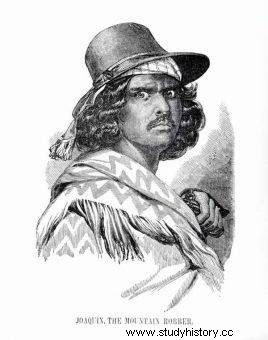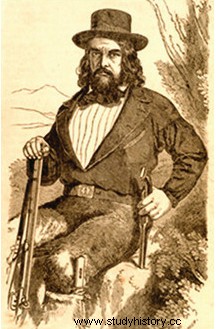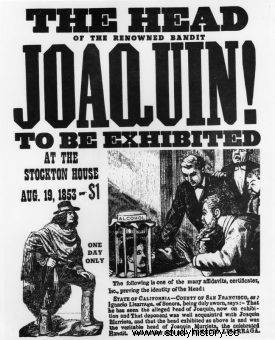Everyone knows the figure of a masked avenger in a black hat and cape, leaving a sign of the letter Z behind him. However, the story of Zorro is a story about the desperation of a group of oppressed people who, as a result of suffering harm and a general sense of injustice, decided to take matters into their own hands - and became a nightmare for American settlers.
California Golden
The first European to set foot on Californian soil was a Portuguese sailor flying the Spanish flag, João Rodriguez Cabrillo. His arrival in the San Diego Bay in 1542 marked the beginning of Spanish domination for the next 279 years. During this period, California performed, inter alia, the role of a stop in the travels of Iberian merchants on the route between their then subordinate Mexico and the Philippines.
The future US state was also very popular with Spanish missionaries. They were not only involved in converting local Indians, but also laid the foundations for future urban centers like San Francisco, Los Angeles and San Jose to which the inhabitants of Mexico willingly came. They had even more pleasure in annexing California in 1821 - first as part of the empire and then part of the republic.
The area remained under new rule for over two decades, until 1846, when it briefly became the independent Republic of California, and then was incorporated into the United States, which had just won the Mexican-American War.
The new stewards had been glancing greedily out towards these southwestern territories for some time. It was caused by rumors of gold hidden somewhere in the sunny, wild hills. Their confirmation triggered the great gold rush, which influenced California over 7 years by approx. 300,000 emigrants from other parts of the USA and Europe.
Birth of the avenger
Unfortunately, the new settlers did not find a common language with the Mexicans living in these areas so far. They were treated by the Americans as big losers who should submit to the new power and new rules , and these placed them lower in the hierarchy than the winners. The situation was also not improved by the news that the Mexicans had been extracting the local gold themselves for several years.
One of them was Joaquin Murrieta. We don't know much about his early life. What is certain is that he was baptized in 1830 in the Catholic rite in Álamos and came from a rural family. He himself, however, had no plans to cultivate the land. His goals were more ambitious - he wanted to provide himself and his young wife with a decent and prosperous life. And that was to await him in California, to which he moved under the influence of his older brother who already lived there and his stories of gold.
Part of the story is that Murriet initially fared very well in her new home . He was going to find his own little El Dorado, hidden somewhere in the hills. It is not known exactly what the value of the gold he started to extract was, but it is estimated that it could have reached $ 300 a day, which in terms of today's amounts is around a dozen thousand dollars. Unfortunately, his happiness was not meant to last long.

Joaquín Murieta (artist unknown, ca. 1848)
American settlers asked for new property and gold-rich areas. Murrieta, of course, was reluctant to hand over his property to the new administrators, for which he would be punished. Legend has it that Joaquin was beaten and then forced to watch a group of torturers torture, rape and eventually kill his wife.
It was not an isolated incident. Many Mexican settlers experienced this kind of aggression and couldn't do anything about it. The new authorities did not feel obliged to protect them. So they lived in fear and a sense of injustice, which sooner or later had to meet some kind of reaction from them. It was in this atmosphere that Robin Hood of El Dorado was born.
Vendetta
After the trials and tribulations he had experienced, Murrieta tried to start his life anew. To this end, he moved to the village where part of his family lived. A peaceful existence, however, was not meant for Joaquin. Soon his brother was wrongly accused of stealing a horse and lynched. His death filled the scales of bitterness. Murrieta, in retaliation for the harm suffered, decided to follow the path of the vendetta.
At first Joaquin took revenge on those who hurt him. His first victim was one of his brother's torturers. He killed him and dismembered him, and then, under cover of night, he threw his remains to an American camp. It was supposed to be a signal to the other oppressors that their time would come faster than they expected.
His actions were quickly noticed by other Mexicans, some of whom wanted to take revenge for their own wrongs. This is how a gang called "The 5 Joaquin" or "The Murrietas" was formed, which included young women and men, including the famous Manuel Garcia "Three Fingered Jack".

Captain Harry Love from California.
They hunted and took revenge on those who persecuted their countrymen. They were mainly murderers and rapists, but also settlers who, after California joined the US, took the gold-bearing lands from Mexicans with impunity. Local press reported a mysterious "M" appearing in raided homes and elsewhere in the group. In the eyes of their kin, the gang was seen as a group of local heroes, but for the Americans, they were bandits and had to be disposed of quickly.
A group of California Rangers was assigned to this task. For the appropriate amount, they were to track down and kill members of the Murrieta gang. The mission was headed by Harry Love, who began tracking the victims by capturing Joaquin's brother-in-law. The torturer was supposed to reveal the location of their hideout.
A tragic end
Love and his companions raided the Avengers on July 25, 1853. Most of the gang were to die in the ensuing battle, including Manuel Garcia and Joaquin Murrieta himself. Ultimately, the guards received $ 6,000 for completing the task, which in today's amounts would be around $ 200,000.
To further emphasize his victory, Harry Love cut off the head that was supposed to belong to Murrieta and Garcia's hand and presented them later to those willing for a fee of $ 1 per person. These peculiar relics were buried in a dignified manner only in 2015.
The problem, however, was that no one knew exactly what the real Joaquin Murrieta looked like. Therefore, questions arose as to whether he was really killed by Love. And although the California authorities tried to reinforce this belief, the legend began to live a life of its own.

Poster advertising the exhibition of Murrieta's alleged head in Stockton, 1853
A year after Joaquin's alleged death, John Rolling Ridge wrote The Life and Adventures of Joaquin Murrieta:The Celebrated California Bandit. The novel not only tells about the fate of the famous bandit, but is also considered to be the first written and published by an author of Indian origin.
Years passed, and the character of Murrieta kept returning in local stories, gaining more and more attention. Eventually, she inspired Johnston McCulley to create the iconic hero Zorro, whose adventures could first be followed on the pages of books and then on screens. To this day, this character appears to everyone as a defender of the oppressed, the Mexican version of Robin Hood.
